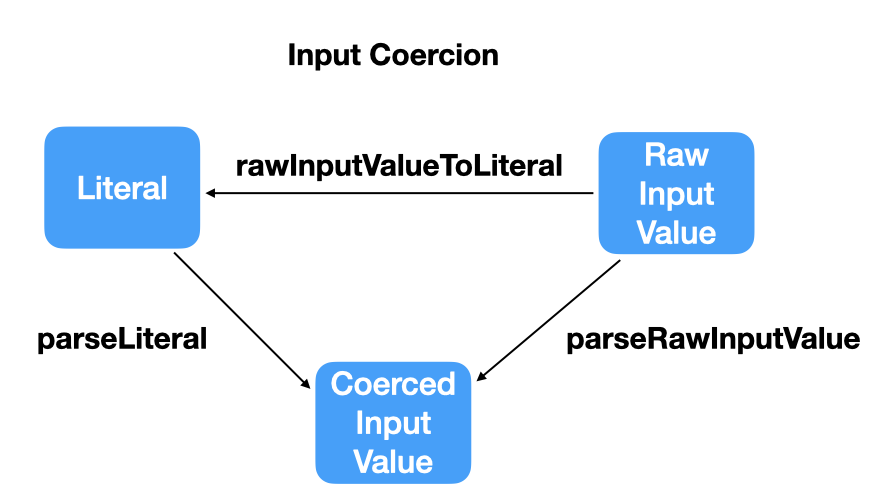GraphQL Scalars implementation guide
Scalar types are primitive types in the GraphQL type system, usable for input and output.
1Serialization and Deserialization
A GraphQL request often requires a deserialization step before being executed and a serialization of the execution result. By far the most frequently used example is a GraphQL request sent over HTTP POST via JSON. The request body is a JSON document that needs to be deserialized, containing the GraphQL document and optionally an operation name and variables.
The execution result then is serialized to JSON for the HTTP response. As JSON serialization is the most common GraphQL serialization format, the spec defines how a GraphQL result should be serialized to JSON.
For the discussion of Scalars, the deserialization of the variables is significant. Deserialized variable values are one of the possible inputs a Scalar implementation needs to handle.
2Observability
A Scalar implementation can be observed in three different ways:
- the serialized result of an execution in JSON
- the variables JSON input
- the GraphQL literal input
We must choose a serialization format in order to observe a Scalar implementation, as inside the GraphQL type system a Scalar is a primitive and how a Scalar is represented in an execution result before serialization is entirely up to the specific engine.
We are choosing to only consider JSON. Although JSON is only one possible serialization format, it is by far the most important and the only format defined by the GraphQL spec.
3Coercion
The process of ensuring that a value is valid and optionally converting it into a more appropriate representation is called “coercion”. For Scalars, there are two different coercion mechanisms: “Result Coercion” and “Input Coercion”. Both are implemented as a set of functions taking an input and producing an output. Result coercion consists of one function and input coercion of up to three different ones.
4Result Coercion values and function
Result coercion is implemented as a single function per Scalar type called coerceResult. The input is a “raw result value” and the output a “coerced result value”. The raw result value is the output of a previously invoked resolver function, which is then coerced by invoking coerceResult.
The coerced result value is a leaf value of the overall execution result, which is serialized to JSON. The serialized JSON value can be observed and a GraphQL Scalar spec must clearly define the possible JSON values that a Scalar type can produce.
5Input Coercion values
Input coercion deals with three different kind of values: literal, raw input value and coerced input value.
5.1Literal
A literal is an element of the GraphQL language representing a fixed value. For example, "foo" is a StringValue literal and 123 is an IntValue literal.
Literals are used for:
- argument values for fields or directives
- argument default values for fields or directives
- variable default values of a GraphQL operation
5.2Raw Input Value
A raw input value is one of the following:
- variable value for a GraphQL request
- programmatically provided default argument value for a field or directive
- programmatically provided default value for an input object field
- programmatically provided value for a directive argument in schema definition language (SDL)
Not every GraphQL implementation may offer a programmatic way to provide these input values, but every implementation needs to allow for raw input values offered as variable values for a request.
The details of a raw input value is implementation specific. In JavaScript, it might a Map, in Java it might be an object. The only way to observe a raw input value is through the JSON value before deserialization.
5.3Coerced Input Value
A coerced input value is a value that is ready for consumption by a resolver. It is coerced either from a literal or raw input value.
6Input coercion functions
Input coercion is implemented as a set of three functions parseLiteral, parseRawInputValue and rawInputValueToLiteral.
The diagram illustrates the relationships between input coercion values.

6.1Parse Literal
parseLiteral takes a GraphQL language literal as input and produces a coerced input value as output.
6.2Parse Raw Input Value
parseRawInputValue takes a “raw input value” as input and produces a “coerced input value”.
6.3Raw Input Value to Literal
rawInputValueToLiteral takes a raw input value as input and produces a GraphQL language literal.
It is used when a literal representation of a raw input value is required. For example the default value for a field in an Introspection response. If a GraphQL implementation doesn’t provide a way to define a raw input value programmatically, rawInputValueToLiteral might not be needed.
6.4Implementation rules
These three functions need to be compatible to each other, specifically:
Rule 1: every valid input for parseRawInputValue must be a valid input for rawInputValueToLiteral and vice versa. This rule ensures that every raw input value can be represented as literal.
Rule 2: for every valid input for parseLiteral there must at least one corresponding input for parseRawInputValue resulting in the same coerced input value. This rule ensures that all literals can be represented as raw input value.
Rule 3: every output for rawInputValueToLiteral must be a valid input for parseLiteral.
These rules ensure that for every valid literal we have at least one valid raw value and vice versa.
7Coercion guidelines
While the specifics of the all coercion methods are implementation specific, as a general rule they should only coerce a value when no information is lost and raise an error otherwise.
Additionally, the input coercion should be liberal in what it accepts, while the result coercion should be much more restricted and never produce different JSON values for logically identical values. For example a MyLocalDate scalar could accept the literals "01-10-2022" and "01102022" as input for the first of October 2022, but the result coercion should always return one of the possible representations.